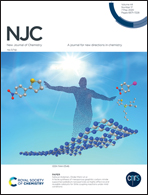Dimerization of heavy atom free tetraphenylethylene with aggregation induced emission for boosting photodynamic therapy†
Abstract
Improving the reactive oxygen species (ROS) generation ability is of tremendous significance in designing photosensitizers (PSs). In this paper, a heavy atom free 4,4′-bis(1,2,2-triphenylvinyl)-1,1′-biphenyl (denoted as BTPE) with aggregation induced emission (AIE) was designed and synthesized by a Suzuki coupling reaction. Then nanoprecipitation with 1,2-distearoyl-sn-glycero-3-phospho-ethanolamine-N-[methoxy(polyethyleneglycol)]-2000 (DSPE-PEG-2000) was used to prepare the NPs. Singlet oxygen sensor green (SOSG) used under irradiation suggests better 1O2 generation ability of BTPE than monomer TPE. In vitro MTT assay on human cervical carcinoma cancer cells (HeLa) demonstrates that BTPE NPs with a half maximal inhibitory concentration (IC50) of 8.4 μg mL−1 are superior to TPE NPs (17.2 μg mL−1), indicating the higher phototoxicity of BTPE NPs. Furthermore, an in vivo study suggests that BTPE NPs are capable of inhibiting tumor proliferation with irradiation but the normal organs, including heart, lungs, liver, spleen and kidneys, suffer from no side effects. Our results indicate that BTPE is able to improve the phototherapy efficacy and simultaneously retains the low toxicity and good biocompatibility, compared with TPE.



 Please wait while we load your content...
Please wait while we load your content...